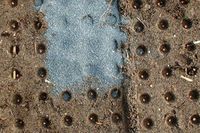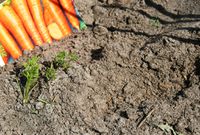- Topic in Gardening courses
Some general rules for sowing
"Prepare the surface earth well, to make a good seed-bed. Plant when the ground is moist, if possible, and preferably just before a rain... For shallow-planted seeds, firm the earth above them by walking over the row or by patting it down with a hoe [I usually do it with the back side of a rake, or with my hand]. Special care should be exercised not to sow very small and slow-germinating seeds, as celery, carrot, onion, in poorly prepared soil or in ground that bakes. With such seeds it is well to sow seeds of radish or turnip, for these germinate quickly and break the crust, and also mark the row so that tillage may be begun before the regular-crop seeds are up.
... Whenever practicable, seed-beds of celery and other slow-germinating seeds should be shaded. If the beds are watered, be careful that the soil is not packed by the force of the water or baked by the sun.
For most home-grounds, seeds may be sown by hand, but for large areas of one crop, one of the many kinds of seed-sowers may be used.
The depth at which seeds are to be planted varies with the kind, the soil and its preparation, the season, and whether they are planted in the open or in the house. In boxes and under glass, it is a good rule that the seed be sown at a depth equal to twice its own diameter, but deeper sowing is usually necessary out of doors, particularly in hot and dry weather. Strong and hardy seeds, as peas, sweet peas, large fruit-tree seeds, may be planted three to six inches deep. Tender seeds, that are injured by cold and wet, may be planted after the ground is settled and warm at a greater depth than before that season."[1]
Seeds and seedlings
In this video:
- True-to-type seeds: you can harvest seeds for propagation from the plants that grow from these seeds, they are not hybrids.
- Don't use recycled potting soil for sowing seeds.
- Try different varieties of vegetables to see which ones you like and fit to your climate.
- Flat seeds need to be planted sideways.
- Store seeds dry and cool.
- You can soak seeds a few hours in warm water before sowing.
- Don't put freshly planted seeds and seedlings in full sunlight.--JE 12:42, 18 September 2012 (PDT)
Transplanting seedlings
The maker of this video plants in a diagonal pattern to gain the most out of his soil and plants. He advises transplanting in the evening to prevent transplant shock.
When seeds didn't germinate well
Sometimes you sow a crop and the seeds don't germinate well. There can be various reasons for this, sometimes bad weather circumstances, or old seeds, etc. In my case, voles dug tunnels underneath my winter carrots. In such a case it is often best to add new seeds in the line. Of course, there should still be enough time in the season for those seeds to grow to full maturity and a good harvest.



